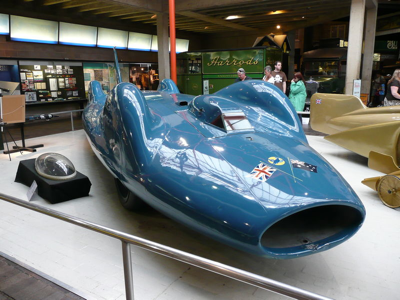
‘Put what you’re trying to do first’
The name Campbell is synonymous with daredevilry and the pursuit of speed records. The first record-breaker in the family was Sir Malcolm Campbell and his son Donald continued the family tradition with speed attempts on land and water. This documentary assumes that the viewer knows that Donald Campbell’s life ends tragically, looks at his obsession with speed and sets out to examine what drove him to take such high risks.
The documentary opens with newsreel footage of Campbell and Bluebird on Coniston in the Lake District. Voiceovers by Campbell himself talk about the risks of record attempts. Within five minutes of the film’s start and before the opening title we are seeing the shocking original footage of Bluebird racing down the lake before flipping over and cartwheeling to destruction. Campbell’s calm words from the cockpit about the noise and lack of visibility are played as the boat approaches the crash, with contemporary eye witness accounts conveying the horror of what was happening.
We are then taken back to learn chronologically about Campbell’s history. His father attempted feats of speed in an earlier age, when such behaviour was adulated. Malcolm Campbell broke the 300mph land speed record in 1935, took more records on water and was regarded as a hero and one of the ‘race of pioneers’. But although Donald was his father’s biggest fan, Malcolm was a difficult parent. One contributor to the film, John Pearson describes Malcolm as being an old bully and remarked that Donald was haunted by his father’s ghost, rather like Hamlet.
After his father’s death Donald took on the challenge of setting a new water speed record in his father’s old boat. Unfortunately it ended in disaster with the boat sinking. This is seen to have spurred Donald on. He gave up his job and poured his life and money into a new machine – Bluebird K7, designed by Ken Morris – a high-tech jet-powered hydroplane. Success at 202mph now drove him on to attempt more records on land as well as water, with financial rewards from Billie Butlin paid at each new record.

Bluebird Campbbell CN7, Beaulieu
Although Campbell died in 1967 he had already survived the fastest crash known to man on the Bonneville salt flats in 1960. He lived in the age of film and there is a lot of footage available of both him and his exploits. This has given the film-makers a lot of images that with their muted, grainy colours work well in a film that ends in tragedy. Combined with interviews with Campbell’s wife and daughter, as well as people on his team, the archive footage is used to great effect to bring a sense of the period with its pre-Health and Safety attitudes.
Donald Campbell: Speed King tells of a driven life that almost seems to have to have ended in tragedy. After all, once you start breaking speed records will you ever be satisfied? It was always possible to try and achieve a slightly faster speed. Campbell believed that once mankind lost the urge to attempt these sorts of records then it would stagnate rapidly. He saw speed records as a sign of a nation’s virility. He is quoted as saying that it is vital to ‘put what you are trying to do first’. Like his father he became obsessed by breaking records – and luckily for us there is lots of film of his attempts.

Leave a Reply